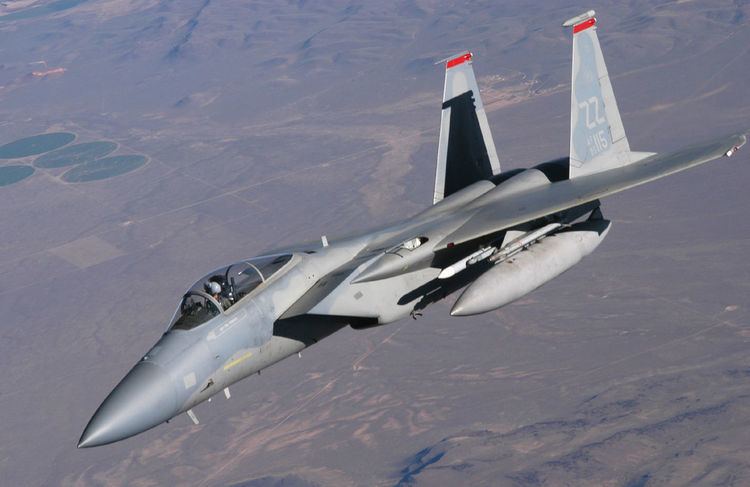 | ||
Active 15 January 1941 - present Part of Pacific Air Forces5th Air Force18th Wing18th Operations Group | ||
The 67th Fighter Squadron "Fighting Cocks" (67 FS) is a fighter squadron of the United States Air Force, part of the 18th Operations Group at Kadena Air Base, Japan.
Contents
Mission
The 67th Fighter Squadron is one of two F-15 Eagle squadrons in the Asian-Western Pacific area of operations, supporting Pacific Command operational plans and headquarters-directed contingency operations.
World War II
Continually active since January 1941, the 67th was activated as a single-engine fighter operational and replacement training unit as part of the 58th Pursuit Group. It was initially assigned to III Fighter Command, and reassigned to I Fighter Command in 1942. Used P-39 Airacobras and P-40 Warhawks for training. Converted to an operational squadron, 1943, re-eqipped with P-47 Thunderbolts.
Deployed to South Pacific Area, 1943, being assigned to the 347th Fighter Group, Thirteenth Air Force. Began combat operations in February 1944, providing protection for U.S. bases and escorting transports initially, then escorting bombers over New Guinea and sea convoys to Admiralty Islands. From Noemfoor, bombed and strafed Japanese airfields and installations on Ceram, Halmahera, and the Kai Islands.
Moved to the Philippines in Nov, flew fighter sweeps against enemy airfields, supported U.S. ground forces, and protected sea convoys and transport routes. Beginning in July 1945, attacked railways, airfields, and enemy installations in Korea and Kyushu, Japan from Okinawa.
After V-J Day, flew reconnaissance missions over Japan. Moved without personnel or equipment to the Philippines in December and demobilized, aircraft sent to depots in the Philippines. Became part of the defense forces of Far East Air Forces in the postwar years at Clark Air Base, being deployed to Okinawa in 1949.
Korean War
As a result of the North Korean invasion of South Korea in June 1950, the squadron was moved from the Philippines to Taegu AB (K-37), South Korea in July. At Taego, the squadron exchanged it's P-80 Shooting Star jets for propeller-driven F-51D Mustangs which were more suited to the ground attack and support role. Combat targets included tanks and armored vehicles, locomotives and trucks, artillery and antiaircraft guns, fuel and ammunition dumps, warehouses and factories, and troop concentrations.
In August, advancing communist forces and insufficient aircraft parking at Taegu forced the unit to move to Japan, but it returned to South Korea the following month to support UN forces in a counteroffensive. Because the front advanced so rapidly, operations from Pusan East (K-9) soon became impractical, and the unit moved in November to Pyongyang East Air Base (K-24), North Korea.
The Chinese Communist (CCF intervention) caused the unit to move twice in as many weeks, first to Suwon AB (K-13), South Korea, then to Chinhae (K-10). From there the unit continued to support ground forces and carry out armed reconnaissance and interdiction missions. Throughout the conflict, the squadron moved from base to base in South Korea. In January 1953 the squadron rejoined the wing at Osan-ni AB (K-55) where it transitioned to the F-86 Sabre without halting the fight against the enemy. It flew its first F-86 counter air mission on 26 February 1953. In the final days of the war, the squadron attacked dispersed enemy aircraft at Sinuiju and Uiju Airfields.
The squadron remained in Korea for some time after the armistice. It was reassigned to Kadena Air Base, Okinawa in November 1954, performing tactical fighter operations in South Korea, Japan, Formosa (later Taiwan), and the Philippines with frequent deployments. In 1957, the squadron upgraded to the North American F-100 Super Sabre.
Vietnam War
Was re-equipped with the F-105 Thunderchief in 1962. As a result of the increased level of combat in Southeast Asia, the squadron was deployed to Korat RTAFB, Thailand, where it carried out tactical bombardment missions over North and South Vietnam in 1965, returning to Kadena AB at the end of October.
Was moved to Misawa AB, Japan in December 1967, being reassigned to the 39th Air Division. Equipment was changed to the F-4 Phantom II, with a to rotate squadrons to South Korea, providing air defense of the nation. Remained in Japan/South Korea until returned to Kadena AB in March 1971, being reassigned back to the 18th Tactical Fighter Wing.
Until 1975, primary mission was the air defense of Taiwan, performing frequent rotational TDYs to Ching Chaun Kang AB. Chinese air defense mission ended with United States' political recognition of Communist China and end of United States military deployments to Taiwan.
Modern era
For the past 35 years, the squadron has operated from Kadena Air Base, providing air defense in the Far East.
2013 Sequestration
Air Combat Command officials announced a stand down and reallocation of flying hours for the rest of the fiscal year 2013 due to mandatory budget cuts. The across-the board spending cuts, called sequestration, took effect 1 March when Congress failed to agree on a deficit-reduction plan.
Squadrons either stood down on a rotating basis or kept combat ready or at a reduced readiness level called “basic mission capable” for part or all of the remaining months in fiscal 2013. This affected the 67th Fighter Squadron with a reduction of its flying hours, placing it into a basic mission capable status from 5 April-30 September 2013.
